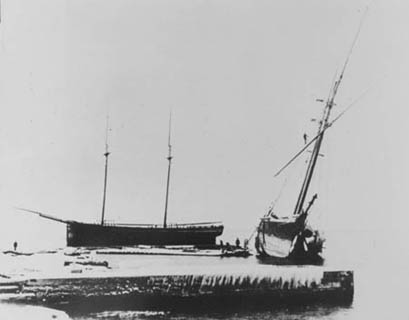Service History
The wooden two-masted schooner
J.E. Gilmore was built in 1867 by Asa Wilcox in his shipyard at Three Mile Bay, New York. Originally rated at 2 1/2 and in 1874 the vessel was valued at $19,000 and rated at A2. At the time of her demise she was rated B1 and valued at $3,500. The Official number was 13307.
1875: The
J.E. Gilmore was sunk at Cleveland, Ohio.
June 1881: Grounded on Gull Island reef.
September 1882: With a load of railroad iron, the
Gilmore went ashore at Oak Point, Caseville, Michigan, Lake Huron.
1882: Major repair.
1887: Damaged by storm, sheltered by Grand Island.
August 1891: With a hold full of coal and a deck load of Souhern pine the
Gilmore developed a leak and went aground at Point Pelee, Lake Erie. The
Saginaw went to her assistance with steam pumps.
Last Document Of Enrollment Surrendered: Cleveland: April 25, 1893: "Loss Of Vessel".
Final Voyage
"The fall of 1892 was a particularly boistrous one even for northern Lake Michigan, which had already experianced some of the worst storms in the recorded history of the Great Lakes. The schooner
J.E. Gilmore, Capt. D.B. Smith, was enroute to Elk Rapids, Michigan, from Chicago without cargo. On October 17, 1892, she was running before the wind through Death's Door in a heavy gale with only a split sail foresail, staysail, and jib. When the schooner was abreast of Pilot Island, the wind shifted ahead to the southwest, driving her from her course and right for the island. Because the
Gilmore was light, she did not carry sufficient sail to be able to tack or clear and did not have time to put it on before striking on the southwest reef about 11:00 p.m. She was tossed up onto a submerged shelf of rock in about three feet of water just ashort distance from the wreck of the
Forest to make a pair of schooners on Pilot Island.
The
Gilmore's keel was crushed and she was solidly settled on the rocky shelf. Although there was no possibility of getting the schooner off, Martin Knudsen, the light house keeper, managed to communicate with the crew. A breeches buoy was rigged up in case of an emergency, but the crew stayed aboard since the cabins were safe and there were enough provisions to last several weeks. They were to be sailed over to the mainland in the lighthouse sailboat when the seas calmed down, but the storm continued to rage and they were still there when the climax was reached 11 days later." Schooner Days In Door County by Walter M. and Mary K. Hirthe.
On October 28,1892, the weather turned much worse and with the crew still on the
Gilmore, they witnessed the
A.P. Nichols join their own fate and become the third vessel wrecked in nearly the same location on Pilot Island. The following day the crews of the
Gilmore and the
Nichols (16 people) were able to make it to the lighthouse. After about a week the seas had subsided enough that the two crews were taken out to the steamer
J.H. Outhwaite bound for Escanaba. The schooners
J.E. Gilmore and the
A.P. Nichols were were abandoned to the underwriters shortly after the disastrous events.
A dive guide for the Pilot Island site is available for purchase.


 Confirmed Location
Confirmed Location
 Unconfirmed location
Unconfirmed location
